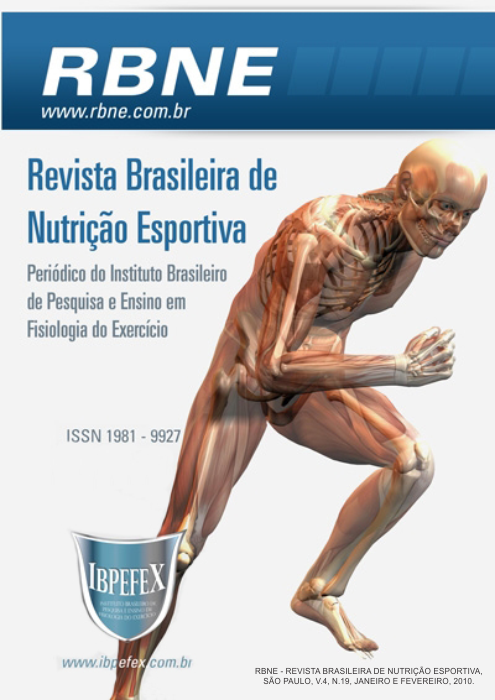Consumption of dietary supplements among physical educators who work in fitness centers in Teresina-PI
Abstract
The body of a physical education professional who works at gyms functions like a résumé that associates good shape with professional quality and this explains why this professional started using dietary supplementation to obtain an ideal body in less time. The purpose of this study was to verify the consumption of dietary supplementation among the physical education professionals who work at gyms in the city of Teresina, state of Piauí. Elements related to the consumption of supplements were investigated in 60 people from 21 to 40 years old in both sexes through application of a questionnaire developed by the researcher. The use of supplements is reported by 61.67% (n=60) sampling. The men use more supplements than the women. The goals that lead to the consumption of supplement are improvement in training (48.64%), followed by aesthetic alteration (40.54%). The supplements more utilized are proteins (37.83%), amino acids (32.43%). 32.40% of the sampling used the product under indication by a nutritionist, followed by salespeople of supplement store combined to friends. 29.7% of the sampling reported to know side effects caused by excessive use of the product such as acne and kidney problems. The consumption of supplements is a practice related to the reality of the gyms and the environment favors the use of these products.
References
-Antunes, A. C. Perfil profissional de instrutores de academias de ginástica e musculação. Revista Digital, Buenos Aires, Ano.9. Num. 60.Mai. 2003.
-Bacurau, R.F.P. Nutrição e Suplementação Esportiva: Exercício de força. 5ª ed. São Paulo. Phorte. 2007. p. 78-93.
-Carmelita,M.;Dias,E.;Gomes,L. Avaliação dos métodos utilizados na busca do corpo perfeito. Rev Brás Ciência Mov. Vol. 13. Num. 4. 2005. P. 281.
-Coelho, C.F.; Camargo, V.R.;Ravagnani, F.C. Consumo de suplementos nutricionais por praticantes de musculação em academias de Campo Grande/MS. Revista Nutrição em Pauta, Campo Grande. Ano.15. Num. 87. Dez. 2007. P.41-45.
-Costa, H.;Rogatto,G. Consumo de suplementos alimentares em homens jovens praticantes de musculação em academias de Cuiabá–MT –Brasil. Revista Bras.Ciência Mov. Vol. 14. Num. 4. 2006. p. 270.
-Cruzat, V.F.; Rogero, M.M.; Borges, M.C.; Tirapegui, J. Aspectos Atuais sobre Estresse Oxidativo, Exercícios Físicos e Suplementação. Revista Brasileira de Medicina do Esporte. São Paulo. Vol. 13. Núm. 5. 2007. p. 336-342.
-Fleck, S.J.; Kraemer, W.J. Fundamentos do Treinamento de Força Muscular. 3ª ed. Porto Alegre. Artmed. 2006. p. 61.
-Hirschbruch, M.D.; Carvalho, J.R. Nutrição Esportiva: Uma Visão Prática. 2ª ed. São Paulo. Manole. 2008. p. 40-45.
-Hirschbruch, M.D.; Fisberg, M.; Mochizuki, L.Consumo de Suplementos por Jovens Freqüentadores de Academias de Ginástica em São Paulo. Rev Bras Med Esporte.Vol. 14.Num. 6. Nov/Dez, 2008.
-Junqueira, J.M. Uso de suplementos nutricionais e conhecimentos dietéticos de freqüentadores de academias de Botucatu/SP. Revista Nutrição em Pauta, Botucatu.Ano.15. Num.85. Jul/ago. 2007.p. 57-63.
-LanchaJr., A. H. Força na largada. Nestlé. Bio., São Paulo. Ano.2. Num.3. 2007. p. 5-8.
-Morais, R.; Medeiros, R.R.; Liberali, R. Eficácia da Suplementação de Proteínas no Treinamento de Força. Revista Brasileira de Nutrição Esportiva. São Paulo. Vol. 2. Núm. 11. 2008. p. 277-287.
-Neiva, C.M. Aspectos gerais e indicadores estatísticos sobre consumo de suplementos nutricionais em academias de ginásticas. Revista Nutrição em pauta, Franca.Ano.15.Num.82. Jan/fev. 2007. p. 27-31.
-Ono, M.Y.Perfil profissional do instrutor de musculação da cidade de Rolândia -PR. 2004. Disponível em.< http:// www.uel.br/cef/TCCPAGINA/RESUMOS/R-111-04. Pdf>.
-Panza, V.P.; Coelho, M.S.P.H.; DI Pietro, P.F.; Assis, M.A.A.; Vasconcelos, F.A.G. Consumo Alimentar de Atletas: Reflexões sobre Recomendações Nutricionais, Hábitos Alimentares e Métodos para Avaliação do Gasto e Consumo Energéticos. Revista de Nutrição. Campinas. Vol. 20. Núm. 6. 2007. p. 683-684.
-Pereira, R.G.; DePaula, A.H. Perfil profissional dos instrutores de academias de musculação da cidade de João Monlevade-MG, Movimentum-Revista Digital de Educação Física -Ipatinga: Unileste-MG -Vol.2. Num.1. Fev./jul. 2007.
-ResoluçãoCFN Nº 390/2006. Regulamenta a prescrição dietética de suplementos nutricionais pelos nutricionistas e dá outras preferências. Disponível em < http://cfn.org.br/novosite/pdf/res/2006/res/390.pdf>. Acesso em: 25, abr. 2010
-Sanches,L.;Apostólico,A.;Rodrigues,F.;Ferraudo,G.;Nacif,M. Uso de suplementos alimentares por praticantes de atividades físicas de uma academia de São Paulo. Rev bras ciênc mov. Vol. 13. Num. 4. 2005. P. 154.
-Santos,A.;Ferreira,P.F. Recurso ergogênico e suplementação: uso no meio atlético. Rev Brás ciên mov. Vol. 11. Num. 4. 2005. p. 61.
-Sapata, B.K.; Fayh, A.P.T.; Oliveira, A.R. Efeitos do consumo prévio de carboidratos sobre a resposta glicêmica e desempenho. Rev Bras Med Esporte.Vol. 12.Num. 4. Jul/Ago, 2006.
-Schneider, A. P.;Machado, D.Z. Consumo de suplementos alimentares entre freqüentadores de uma academia de ginástica de Porto Alegre/RS. Revista Nutrição em Pauta, São Paulo. Ano.15. Num. 78. Jun. 2006. p. 12-15.
Authors who publish in this journal agree to the following terms:
- Authors retain the copyright and grant the journal the right of first publication, with work simultaneously licensed under the Creative Commons Attribution License BY-NC which allows the sharing of the work with acknowledgment of the authorship of the work and initial publication in this journal.
- Authors are authorized to enter into additional contracts separately for non-exclusive distribution of the version of the work published in this journal (eg, publishing in institutional repository or book chapter), with acknowledgment of authorship and initial publication in this journal.
- Authors are allowed and encouraged to post and distribute their work online (eg, in institutional repositories or on their personal page) at any point before or during the editorial process, as this can bring about productive change as well as increase impact and impact. citation of published work (See The Effect of Free Access).






